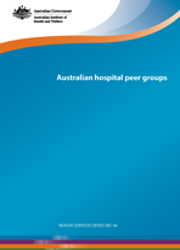Summary
This publication details a new peer grouping for Australian public and private hospitals. It has been developed by the Australian Institute of Health and Welfare (AIHW) in consultation with a wide range of stakeholders in Australia's public and private hospital sectors.
Why peer group hospitals?
Hospital peer groupings define groups of similar hospitals based on shared characteristics, and allow a better understanding of the organisation and provision of hospital services. Also, when presenting and analysing health performance and other information, it is important that valid comparisons are able to be made. For hospitals, a peer grouping supports comparisons that reflect the purpose, resources and role of each hospital.
Why have a new peer grouping?
The AIHW's original peer grouping was developed in 1999 for public hospitals only and was mainly based on the workload of the hospital (measured as admitted patient separations or acute weighted separations) and the hospital's remoteness area. Peer groups for some hospitals were based on their specialised roles as reported by states and territories.
The methodology used to group hospitals had not been updated since its original development, and changes in hospital workloads and work practices highlighted the need for a review. For example, increases in hospital activity resulted in hospitals moving up the size-based peer groups, making some of the groups too large and heterogeneous.
New AIHW hospital peer grouping
The new AIHW peer grouping has been developed as a flexible and robust method to categorise hospitals. The peer groups:
- are based on data from a broad range of sources. Unlike the previous peer grouping, the new method does not rely on advice from service providers alone to create particular groups
- are intended to be multipurpose. The original peer grouping was used for purposes beyond those originally envisaged. The new groups are defined according to broad service profile characteristics and do not target any particular reporting purpose
- are intended to be stable over time. The groups have been defined by the type and nature of the services provided rather than by size-based characteristics, which can change through increases in activity
- include private hospitals for the first time.
The new AIHW peer grouping comprises 36 peer groups, 9 for hospitals mainly providing acute care, 11 for overnight hospitals with specialist roles, 2 for hospitals mainly providing sub- and non-acute care, 13 for hospitals treating patients on a same day basis and 1 for hospitals mainly providing non-admitted patient care. Some peer groups include both public and private hospitals, but there are also those specifically for private hospitals and those specifically for public hospitals. These sector-specific peer groups are not intended to support comparison between sectors.
Summary
- Why peer group hospitals?
- Why have a new peer grouping?
- New AIHW hospital peer grouping
1. Introduction
- Purpose of this publication
- What are hospital peer groups and why use them?
- Previous AIHW peer grouping
- Need for a revised AIHW hospital peer grouping
- Aims of the revision
- Other hospital peer groups used in Australia and internationally
- Publication structure
2. Development of the new peer groups
- Scope
- Consultation
- Data analysis
- Terminology used in this report
- Future changes
3. Australian hospital peer groups
- About the peer group descriptions
- Acute hospitals
- Specialist overnight hospitals
- Sub- and non-acute hospitals
- Very small hospitals
- Day hospitals
- Outpatient hospitals
- Unpeered hospitals
Appendix A: Data and information sources
Appendix B: Previous AIHW public hospital peer groups
Appendix C: Alphabetical listing of public and private hospitals by peer group
Appendix D: Listing of public and private hospitals by peer group
Appendix E: Private hospitals that mainly provide public hospital services
End matter: Acknowledgments; Abbreviations; Symbols; Glossary; References; List of tables; List of boxes



